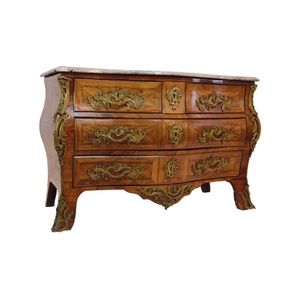French Floral Inlaid Bombe Secretary with Marble Top
You must be a subscriber, and be logged in to view price and dealer details.
Subscribe Now to view actual auction price for this item
When you subscribe, you have the option of setting the currency in which to display prices to $Au, $US, $NZ or Stg.
- Veneers - Veneers are thin sheets of well-figured timber that are glued under pressure to the surface of a cheaper timber for decorative effect, and then used in the making of carcase furniture.
Early veneers were saw-cut so were relatively thick, (up to 2 mm) but is was realised that saw cutting was wasteful, as timber to the equivilent of the thickness of the saw was lot on each cut.
A more efficient method was devised to slice the timber, either horizontally with a knife, or in a rotary lathe.
Flame veneer, commonly found in mahogany or cedar furniture, is cut from the junction of the branches and main trunk. So-called fiddleback veneers, where the grain is crossed by a series of pronounced darker lines, is usually cut from the outer sections of the tree trunk.
During the 17th and 18th centuries, and in much of the walnut marquetry furniture made during the latter part of the 19th century, the veneer was laid in quarters, each of the same grain, so that one half of the surface was the mirror image of the other.
The use of veneer allows many other decorative effects to be employed, including stringing, feather banding, cross banding, and inlaid decorative panels in the piece. The carcase over which veneer is laid is usually of cheaper timber such as pine, oak or, sometimes in Australia during the first half of the 19th century, red cedar.
The important thing to remember about veneers is that prior to about 1850 they were cut by hand, and were consequently quite thick - ranging up to about 2mm deep.
From the mid-19th century veneers were cut by machines and were almost wafer-thin. This is a critical point when trying to judge the approximate age of veneered furniture. - Bombe Front - More commonly associated with a dome shaped dessert, "bombe" in furniture parlance means "puffed out". In profile the piece is serpentine shaped, narrow at the top, swelling out towards the middle and continuing to the floor, though sometimes it narrowed again at the foot. Drawer fronts are curved in section. Bombe pieces are often highly decorated with marquetry inlay, or veneered and set with brass or ormolu mounts. The most common use of the word, is in the description of the 'bombe commode'.
The bombe design was particularly popular in the 18th century, during the reign of Louis XIV, when it was used to create furniture pieces with a curved, rounded bulging shape. This design was used on furniture in many styles, including Baroque, Louis XIV, Louis XV and Louis XVI. The bombe chest is one of the most iconic furniture piece featuring this design. They were usually made of precious woods like mahogany, rosewood, and walnut, and feature elaborate inlay, gilded ornaments and ormolu. Other items of furniture where the bombe design can be seen include cabinets, commodes, and desks. - Inlay - Decorative patterns inserted into the main body of a piece of furniture, generally in wood of contrasting colour and grain, though brass, ivory, ebony, shell and sometimes horn have been used. Inlay may consist of a panel of well figured timber inset into a cabinet door front, geometric patterns, or complex and stylized designs of flowers, swags of foliage, fruits and other motifs. As a general rule, in pieces where the carcase is constructed in the solid, the inlay is relatively simple such as stringing, cross banding and herringbone banding. Where more elaborate and decorative work was required veneer was used. Inlay has been fashionable from at least the latter half of the 17th century, when a variety of elaborate forms were developed
This item has been included into following indexes:
- desks, style or type
Visually similar items

A French Louis XV style kingwood and marquetry fall front desk. 130 cm high, 75 cm wide, 35 cm deep.

A Continental marquetry bombe commode chest, early 20th century. 90 cm high, 106 cm wide, 70 cm deep

A French kingwood floral marquetry decorated secretaire - abattant, the rectangular marble top, above an inverted cornice, below a fall front with Vernis Martin painted panel with ormolu surround, enclosing leather writing surface pigeon holes and small dr

A Louis XV rosewood and bronze mounted bombe commode, French 18th century. 88 cm high 130 cm wide, 68 cm deep
